
TimeSplitters 2 is a first-person shooter video game, developed by Free Radical Design, published by Eidos Interactive, and released in 2002 for PlayStation 2, Xbox and GameCube. The game's story focuses on the efforts of a space marine who seeks to recover powerful time crystals from a race of alien mutants called TimeSplitters, which leads them to taking on the form of an individual dealing with their own problems across different time periods between the 19th and 25th century. The developers focused on expanding the story element following 2000's TimeSplitters, and features influences from various film genres, including Horror, Action and Science Fiction.

Tom Clancy's Splinter Cell: Pandora Tomorrow is a 2004 stealth game developed and published by Ubisoft Shanghai and Ubisoft Milan. The game is the sequel to Splinter Cell and the second game in the Splinter Cell series endorsed by writer Tom Clancy. It follows the covert activities of Sam Fisher, an agent working for a black-ops branch of the National Security Agency (NSA) called "Third Echelon". Michael Ironside returns to voice Sam Fisher, while Dennis Haysbert voices the character Irving Lambert, Fisher's boss, making this the only time he is not voiced by Don Jordan. Lalo Schifrin provides the theme music for the game.
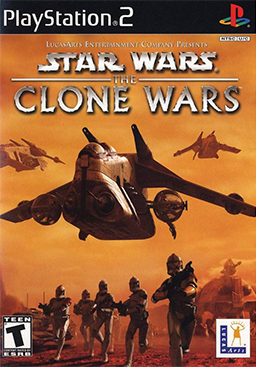
Star Wars: The Clone Wars is a video game set in the Star Wars universe developed by Pandemic Studios and published by LucasArts for GameCube, PlayStation 2 and Xbox. It consists mostly of vehicular combat using clone warships, starfighters, speeder bikes and tanks, as well as missions where players can control Anakin Skywalker, Obi-Wan Kenobi, or Mace Windu on foot. The game is set in the Star Wars prequel trilogy era, with the first level encompassing the Battle for Geonosis from Episode II: Attack of the Clones. The game also features multiplayer modes for up to four players in splitscreen, or online via Xbox Live for the Xbox. It holds aggregate scores of 73 out of 100, 72 out of 100 and 71 out of 100 on review aggregator Metacritic for the GameCube, PlayStation 2, and Xbox, respectively.
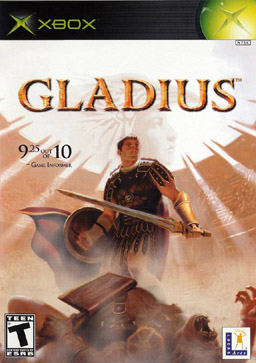
Gladius is a tactical role-playing video game developed and published by LucasArts. It was released in 2003 for the GameCube, PlayStation 2 and Xbox.

TimeSplitters is a series of first-person shooter video games developed by Free Radical Design. The games are often considered spiritual successors to the Nintendo 64 titles GoldenEye 007 (1997) and Perfect Dark (2000), due to overlapping elements in gameplay, design, and development team. Each game features a time travelling element in which players battle across a diverse number of locations and periods in history.

Burnout 2: Point of Impact is a 2002 racing video game developed by Criterion Games and published by Acclaim Entertainment for PlayStation 2, GameCube and Xbox. It is the sequel to the 2001 video game Burnout and the second title in the Burnout series. It was the last Burnout game to be released on the GameCube and the series would not see a release on a Nintendo platform until the release of Burnout Legends in 2005. The game also marked Acclaim's last entry in the Burnout series, as Acclaim would go bankrupt in 2004; the rest of the series would be published by Electronic Arts.

Madden NFL 06 is an American football video game released in 2005. It is the 16th installment of the Madden NFL series by EA Sports, named for color commentator John Madden. It is the first Madden game for the PlayStation Portable and Xbox 360 and was a launch game for the 360. Philadelphia Eagles quarterback Donovan McNabb is on the cover.
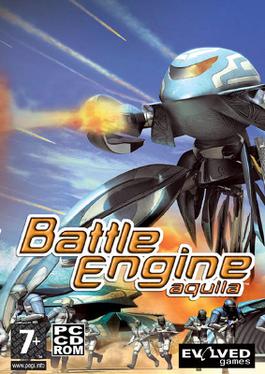
Battle Engine Aquila is a 2003 video game for PlayStation 2 and Xbox developed by Lost Toys and published by Infogrames Europe. In the game the player pilots the Battle Engine for the Forseti military in their wars against the Muspell to decide who will rule what's left of the world. Battle Engine Aquila received little attention from the public despite overall good reviews from critics. It was listed as #86 in the Top 100 Games for PlayStation 2 by IGN. A later Microsoft Windows port was published by Encore Software.

Juiced is a racing video game by British studio Juice Games for Microsoft Windows, PlayStation 2, Xbox, and mobile phones. The game was delayed for release in 2004 because the original publisher, Acclaim Entertainment, went defunct. Juice Games and Fund 4 Games retained ownership of the property and sold the game to THQ, who funded the project for a further six months of improvements. In early 2006, British software publisher Focus Multimedia re-released the PC version of Juiced at a new budget price as part of its "Essential" games series. The game offers different modes including career and arcade that present the player with challenges of increasing difficulty. The player can customise the car to suit their style and unlock new ones in arcade mode. The game features nitrous boosts, similar to that of other racing games. Juiced went to number one in the United Kingdom MCV sales charts and its first version sold 2.5 million units.
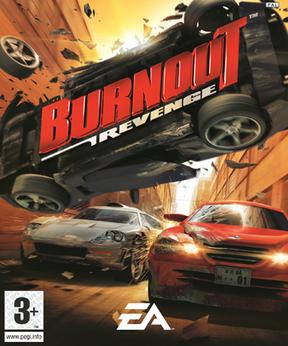
Burnout Revenge is a 2005 racing video game developed by Criterion Games and published by Electronic Arts for PlayStation 2, Xbox and Xbox 360.
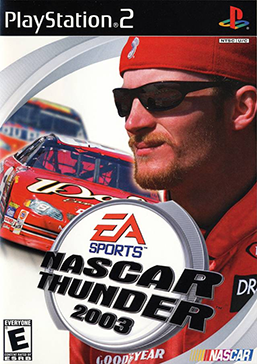
NASCAR Thunder 2003 is the sixth edition of the EA Sports' NASCAR racing simulator series. Developed by EA Tiburon and Budcat Creations and published by EA Sports. It was released for PlayStation, PlayStation 2, GameCube, and Xbox on September 18, 2002, and for Microsoft Windows on October 21. The product features Dale Earnhardt Jr. on the cover. It was the first time the NASCAR's Most Popular Driver Award recipient was featured on the cover, although he did not win the award for the first time until the following year. Dale Earnhardt appeared in the game as a driver as a result of entering his name as a Create-A-Car driver's name; he did not appear in the previous game due to his death. He appeared as a legend in subsequent games.
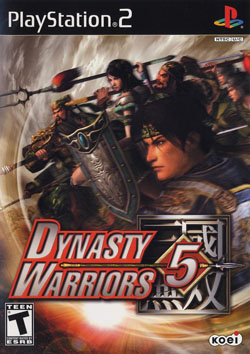
Dynasty Warriors 5 is a hack and slash video game set in China and the fifth installment in the Dynasty Warriors series, developed by Omega Force and published by Koei. The game was released on the PlayStation 2 and Xbox. It is based on the Chinese novel Romance of the Three Kingdoms by Luo Guanzhong.

OutRun 2006: Coast 2 Coast is a racing game developed by Sumo Digital and published in 2006 by Sega. It is the 9th title in the series, and the final one to have a physical release. Outrun 2006 is an updated version of OutRun 2. The game is split into two parts: a conversion of OutRun 2 SP and "Coast 2 Coast", which includes single-player races and challenges, and local network and internet multiplayer.

Buffy the Vampire Slayer: Chaos Bleeds is an action beat 'em up video game developed by Eurocom Entertainment Software and published by Vivendi Universal Games. It is the fourth game in the Buffy the Vampire Slayer franchise, and the only multiplatform game. It was the first to allow players to control characters other than Buffy Summers and feature a fully developed multiplayer mode.

SpyHunter is a vehicular combat game. It is a remake and sequel of the 1983 arcade game of the same name first released for PlayStation 2 in 2001. It has since been ported to GameCube, Xbox, Game Boy Advance, Microsoft Windows, OS X, and Tapwave Zodiac. In the game, the player drives the G-6155 Interceptor, an advanced, weaponized spy vehicle. Unlike the original's top-down view, the remake is played with a chase camera, similar to a racing game.

Ford Racing 3 is a racing video game published by Empire Interactive, 2K, and ZOO Digital. It is the third game in the Ford Racing series, and was released in Europe in October 2004, for Microsoft Windows, PlayStation 2 and Xbox. In the United States, the game was released on the same platforms the following year, followed by releases later that year for the Game Boy Advance and Nintendo DS. Visual Impact Productions developed the GBA and DS versions, while Razorworks developed the other versions. The game received mixed reviews, critics were divided in its soundtrack, physics and overall content and gameplay.

TimeSplitters is a first-person shooter video game, developed by Free Radical Design, published by Eidos Interactive, and released in 2000 as a PlayStation 2 launch title. The game's premise focuses on players controlling a variety of different characters across different time periods over a span of 100 years, seeking to resolve a personal matter involving their own foes, which brings them into contact with an alien race known as the TimeSplitters, who seek to interfere.

Star Wars: Battlefront is a 2004 first and third-person shooter video game based on the Star Wars film franchise. Developed by Pandemic Studios and published by LucasArts, it is the first installment in the Star Wars: Battlefront series. It was released on September 21, 2004, for PlayStation 2, Xbox and Microsoft Windows to coincide the release of the Star Wars Trilogy DVD set. Aspyr released a Mac OS X port in July 2005, and a cellular phone version, Star Wars Battlefront Mobile, was released on November 1, 2005.
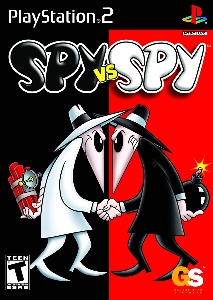
Spy vs. Spy is a video game developed by Vicious Cycle Software and published by Global Star Software. The game is based on the MAD magazine's titular comic strip. The game features the two spies in a unique story mode, plus two other game modes, and a multiplayer mode for up to 4 players. A GameCube version was planned, but it was cancelled. The overall gameplay is a modernized version of the older Spy vs. Spy series of games in 3D environments.


















